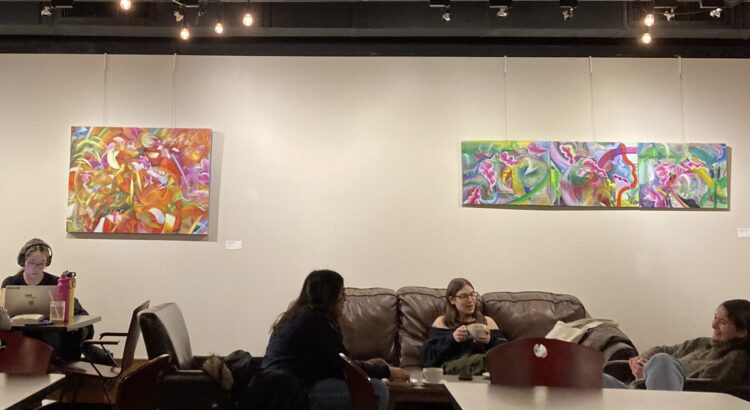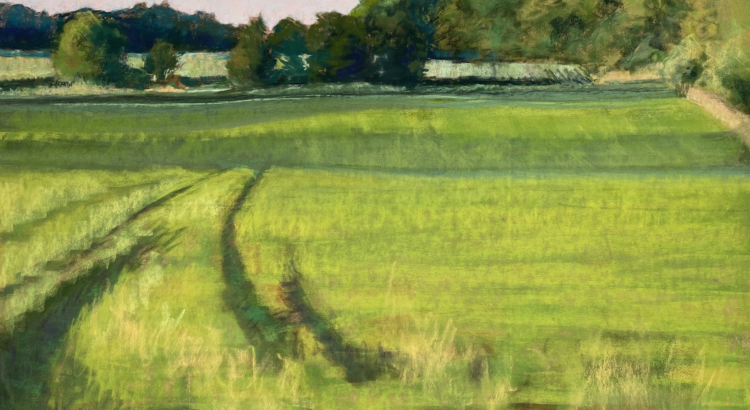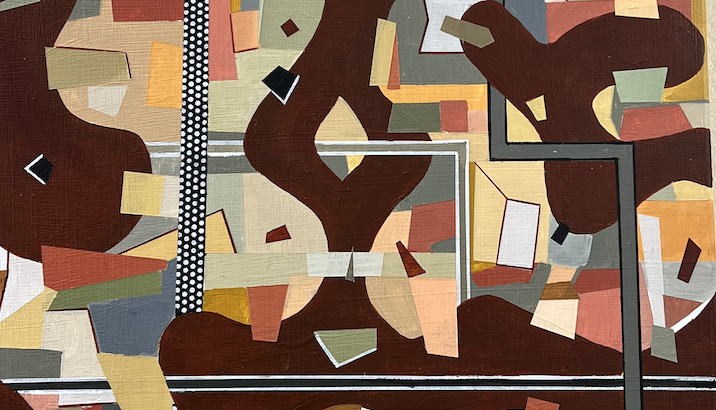Journey of Self-Discovery was quite a journey, indeed. I spent a good forty minutes perusing the paintings, scoping out the sculptures.
Upon entering the gallery, I chatted with the facilitator, who told me that two-thirds of the art had already been sold, as Rich’s work at the Dude was for sale through donation, the proceeds of which went directly to support a local grass roots food pantry ministry that serves areas of Ann Arbor.
The whole gallery, every space in it, was filled with a rich arrangement of whimsical paintings and sculptures. (Pun slightly intended.)

Hallucinations made me a little sick to stare at, like an onslaught of auras about to precede a migraine. A dark, whirling enchanted forest; walk through the maze and you’ll get woozy.

In Ignite, some of the scratched-off paint and its meddled, worn-by-time quality echoed graffiti. “ROM” in the corner made me wonder what other words might be hidden. The piece had the playfulness of a childhood scribble where we’d take our nails to a paper of crayon and get wax curled beneath them, but also the mastery of someone whose paid years of practice.

Spark’s thin, intricate mess of scrapes creates texture and noise. Almost like nails scratching against walls, it feels chaotic yet harmonious. It is quite a feat to achieve a composition of random shapes and colors with no recognizable pattern, that doesn’t border on busy, or unbalanced.

Are you there? haunted me, just from the title. I looked into the abstract and tried to pull something out. It took a few seconds, but I couldn’t help seeing a baby in a womb, floating, unattached to an umbilical cord, living lost in the guts of a mother.

Balancing Act feels like a futuristic, hypertech playground world, or the next version of the board game Chutes and Ladders.

Future Daze gave off the lonely monotony of a city. I got a glimpse into the banalities of the everyday life of a citygoer. Vibrating with texture and pulse, peering into the painting feels like getting caught in a daunting big place, where you feel like one of millions of others. But the muted palette gives a sense of calmness, dullness, of having gotten used to it, enough to call this bustling place home.

I can’t help seeing some kind of creature in Concentricity, like a silly red panda or raccoon, calling out to me with crossed eyes, just to make me double-take in disbelief.

Junk Drawer Wisdom – a very interesting title. As if claiming it may be messy, but it’s an organized mess, because you know where things are in the clutter.
Suspension feels cakey, creamy; I don’t rly have the words to describe it, but it’s my favorite thus far. Maybe it’s the colors on the left or the texture that I have no idea how Rich achieved, but it feels like a unique ROM texture – a little Jackson Pollock, but more smooth than spattered.

Sitting Meditation was interesting. Especially because the rounded pod-like windows resemble the little apartments in the graphic novel, Apsara Engine. I would think a meditation calm, and maybe this one is, despite the overwhelming cogs-in-machine way about it. Because puzzle pieces are slotting into place, blocks are getting put away into boxes, things getting maneuvered into their rightful place. Thoughts are being stored away, put to rest, so the mind can quiet and not have all these anxieties sitting around, waiting to jump in. The white outline is like the cable in Monsters Inc bringing doors back to their homes.

Blast felt kinda mischievous. There’s a lopsided smiley face at the bottom center and a rounder circle encasing it. It reminded me of those No, David! children’s books because of the one spike on its head, which is so characteristic of a trouble maker (also like Jack Jack from The Incredibles). The black squiggles in the second quadrant are as if he just took to his hair with a pair of safety scissors, and mom is about to come through that yellow door on the right and have a heart attack when she sees him and the mess he’s made.

Tongue in Cheek is a potato cornucopia. A little potato society. There is a potato statuette, like the potato is on top of the world, sailing on a boat.

Got Dopamine? is fun: I couldn’t stop seeing all these silly faces in it. Maybe not all particularly happy or pleased expressions, but they gave me little bursts of dopamine.

Emerge looked like a mouth full of teeth and gums and bacteria, in full sickness. When will you emerge from your room? Pop off your bed? Not today.



I like the way Hanging ‘Round moves as you shift around it. This was just one of the many wood constructions and carvings, which all had so much movement for such a dead thing as the innards of a cut tree.

In Equine Driver, I see a sassy cat and a skirting teacup, like that of Chip from Beauty and the Beast. He is pretending to be a sailboat. Is the cat’s eye slanted at him, or the judgers?

Rhythmic Reverberation felt like it touched directly into my chest. I could hear the soundscape of nostalgic beeps and boops, glowing notes shooting through wires.


Forest For The Trees was fun. I had to wait to have my turn with this one. I witnessed a professor-like observer, an older man with glasses and a tweed coat, humming a sound of playfulness, of delight, humor, at shifting his perspective and seeing how the forest moves, like the whole swath of trees is turned on its side.
If there’s anything I’ve learned from walking around Rich’s gallery, it’s that the aesthetically pleasing – the ones that are easy to look at, that I’d be more inclined to buy or hang up in my house – are not the ones that tell a story, as much as the funky friends, the outcasts.
When I got home, my roommate saw Rich’s card on my desk and burst out in an accusatory smile, because apparently she worked there, at the Dude gallery! She had met Richie, his wife, and his family members who stopped by the exhibit; I had just missed her. I asked what he was like. She said Rich acts like his art. He talks with his hands, and does this thing when he talks, where he moves his head in a looping motion as if he’s drawing infinities with his ears. My roommate delighted in his art because she feels happiest when art, especially her own, is playful. I agree. Journey of Self-Discovery felt like a joyful, eccentric playground that you could dance through, get lost in.







































